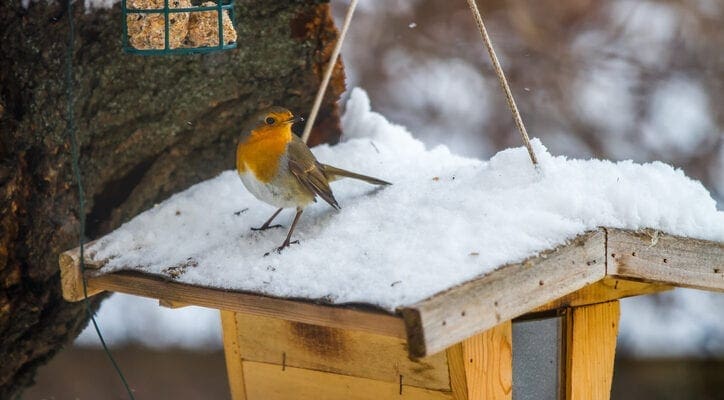There are a number of simple steps that you can take to make your garden welcoming to robins before the weather begins to turn too cold…
During a cold winter up to half our garden birds can be lost to cold and hunger. Robins are particularly susceptible as they remain faithful to their gardens no matter what the weather. Putting out food, water and shelter for birds visiting your garden can make a big difference to survival rates.
What food can support robins and other winter birds?
Garden bird populations all over the UK have fallen by up to 50% in the last few decades, so all of them are in some level of trouble. Because there are fewer hedgerows, there is a lack of natural food. Without supplementary bird feeding in gardens, up to half of robins could die of cold and starvation.
The best foods to put out for robins are:
- Mealworms and calcium worms, which are especially beneficial because they are insectivores
- Fatty foods like suet pellets
- Special high protein robin blends
- Meaty kitchen scraps
- Mild cheese
- Cake and biscuit crumbs
- Dried fruit
- Peanuts (shredded or crushed)
Robins prefer to forage and feed off the ground. By placing a small food tray full of their favourite food close to a shrub tree or preferred perch, you can encourage them to make your garden home and spend more time with you day by day. Ark Wildlife have a robin feeder pack which could get you started – if you’re lucky, after a little time robins can quickly become confident in our presence and feeding from the hand is not unknown!
How to make your garden a home for robins
Birds cluster together during very cold spells to share their warmth. They often use nest boxes as winter shelter, so put up suitable bird nest boxes in winter. These will be used as night roosting sites as well as places for nesting in the spring. Nest boxes should be placed at least 2m from dense vegetation in order to prevent surprise attacks from cats.
Place plenty of water sources in the garden. Bird tables make a big difference to the survival of robins in urban and suburban areas. As with any garden wildlife, it’s also worth ensuring that your garden isn’t too pristine or tidy – some wild undergrowth will encourage the proliferation of insects and help robins to find food.
How can the public support hedgerow habitats?
Megan Gimber, Key Habitats Project Officer at PTES, offers insight for how the public can help the UKs hedgerows:
“Last year we launched the Great British Hedgerow Survey to help health check the nation’s hedges. After any hedgerow is surveyed, you will get instant results about how healthy each hedge is and bespoke advice about the best way to manage it going forward. The more we know about the health of our hedgerows, the better we are able to direct our conservation work.
“Hedgerows are bejewelled with hawthorn berries, rose hips, sloes and a myriad of other fruits in the autumn, and can be a veritable larder for birds and small mammals preparing for winter. Migratory birds such as fieldfares and redwings that overwinter with us will also seek food from our hedgerows and traditional orchards.”
Where to get more information
Charities to support or sources of information:





